Description
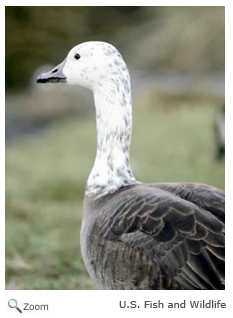 The snow goose is
25-33
inches in length with a wingspan of 54 inches. It has a black on the edges of its orange-pink bill that makes it look like it is smiling! It has black wing tips, pink legs and feet, and black eyes. It has two color patterns. It can be white all over or bluish-gray with
light brown underparts and a white head and neck. The bluish-gray snow goose is sometimes called the blue goose and was once thought to be a separate species. The snow goose is
25-33
inches in length with a wingspan of 54 inches. It has a black on the edges of its orange-pink bill that makes it look like it is smiling! It has black wing tips, pink legs and feet, and black eyes. It has two color patterns. It can be white all over or bluish-gray with
light brown underparts and a white head and neck. The bluish-gray snow goose is sometimes called the blue goose and was once thought to be a separate species.
Range  The snow goose breeds
in the Arctic regions of North America, including Greenland. In the winter it is found on the Pacific Coast from British Columbia , Canada to California, on the mid-Atlantic Coast, and on the Gulf Coast from Mississippi to Texas. It also winters in small numbers in the interior of the U.S. The snow goose also breeds in Siberia. The snow goose breeds
in the Arctic regions of North America, including Greenland. In the winter it is found on the Pacific Coast from British Columbia , Canada to California, on the mid-Atlantic Coast, and on the Gulf Coast from Mississippi to Texas. It also winters in small numbers in the interior of the U.S. The snow goose also breeds in Siberia.
Habitat
The snow goose
breeds on sub arctic and arctic tundra, near ponds or streams
and winters in coastal saltwater marshes and bays, wet grasslands, freshwater marshes, and fields and farmland.
|
|
Diet
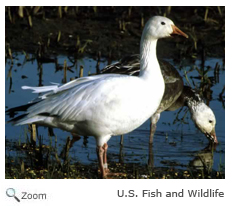 The snow goose is an herbivore. It feeds in
water-logged soil or shallow water
and
eats a variety of plant species and parts, from aquatic plants to grasses and grain. Some of their favorite foods include grasses, sedges, willows, rushes, and horsetails. Snow geese will eat all parts of a plant from seeds, leaves, and stems to tubers and roots. They graze for seeds and grain above the ground and also grub around and rip up plants by the roots. In the winter, they feed on left over grain and new shoots on farmland. The snow goose is a voracious eater. They have to be, food passes though their digestive system in only an hour or two! The snow goose is an herbivore. It feeds in
water-logged soil or shallow water
and
eats a variety of plant species and parts, from aquatic plants to grasses and grain. Some of their favorite foods include grasses, sedges, willows, rushes, and horsetails. Snow geese will eat all parts of a plant from seeds, leaves, and stems to tubers and roots. They graze for seeds and grain above the ground and also grub around and rip up plants by the roots. In the winter, they feed on left over grain and new shoots on farmland. The snow goose is a voracious eater. They have to be, food passes though their digestive system in only an hour or two! Life Cycle 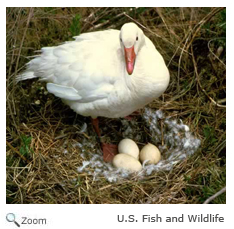 Snow goose pairs form in the spring and nest in colonies. The female lays 2-5 white eggs in a scrape in the ground lined with dried plant parts and down. The male guards the nest while the female incubates the eggs. The gosling hatch in 22-25 days. The goslings leave the nest within two days of hatching and can swim and feed themselves. The goslings stay with their parents through the first winter and migrate with them in the fall and then again in the spring back to the breeding grounds. Male and female pairs usually mate for life. Snow goose pairs form in the spring and nest in colonies. The female lays 2-5 white eggs in a scrape in the ground lined with dried plant parts and down. The male guards the nest while the female incubates the eggs. The gosling hatch in 22-25 days. The goslings leave the nest within two days of hatching and can swim and feed themselves. The goslings stay with their parents through the first winter and migrate with them in the fall and then again in the spring back to the breeding grounds. Male and female pairs usually mate for life.
Behavior
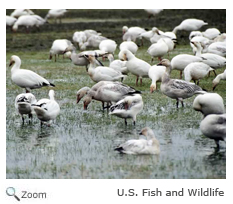 Snow geese migrate in large flocks and fly during both night and day. They rest and feed on marshes and other wetlands during their migration. They usually return to the same nesting area each year. Snow geese migrate in large flocks and fly during both night and day. They rest and feed on marshes and other wetlands during their migration. They usually return to the same nesting area each year.
|

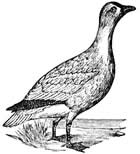

 The snow goose breeds
in the Arctic regions of North America, including Greenland. In the winter it is found on the Pacific Coast from British Columbia , Canada to California, on the mid-Atlantic Coast, and on the Gulf Coast from Mississippi to Texas. It also winters in small numbers in the interior of the U.S. The snow goose also breeds in Siberia.
The snow goose breeds
in the Arctic regions of North America, including Greenland. In the winter it is found on the Pacific Coast from British Columbia , Canada to California, on the mid-Atlantic Coast, and on the Gulf Coast from Mississippi to Texas. It also winters in small numbers in the interior of the U.S. The snow goose also breeds in Siberia.

